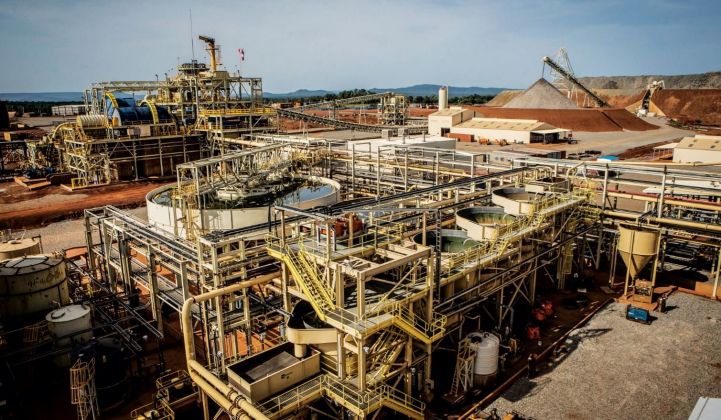Many of the topics discussed at the Energy and Mines World Congress earlier this month would have been borderline laughable just a few short years ago. For example, a panel of senior mine executives considered which milestone would likely be achieved first: fully electric mines, decarbonized fleets or 100-percent-renewable-energy-powered operations.
The fact that a topic like this was being seriously debated is a reflection of just how much both the renewable energy and mining industries have evolved in recent years. While large companies that mine for the likes of gold, copper, lithium and cobalt have increasingly voiced the importance of lowering their carbon emissions, pure economics is the real driver behind interest in solar, wind and energy storage.
Total energy costs can be anything from 15 to 40 percent of a mine’s operating costs. Electricity demand has traditionally been met by grid energy and/or heavy fuel oil like diesel to run mining equipment. Globally, mining operations require a lot of energy. According to a report by the Columbia Center on Sustainable Investment, the sector accounts for between 1.25 percent and 11 percent of total global energy demand, with the wide variation due to which downstream activities are included in the calculation.
Because many mines are in remote locations, expensive fuel must be transported long distances and grid energy is often unavailable or unreliable. Continuously declining costs for wind, solar and energy storage have made clean energy an economically attractive option. According to Wood Mackenzie, the cost of energy storage in 2022 will be 61 percent less than in 2013, and the cost of solar will be 40 percent lower.
These and other factors have spurred clean energy installations at mines across the globe. According to the Rocky Mountain Institute’s Renewable Resources at Mines tracker, there are nearly 1.8 gigawatts of renewable capacity installed at 88 sites across 26 countries, plus more than 3 gigawatts of planned projects.
Adding solar-plus-storage in Mali
In early December, the Canadian gold-mining company B2Gold announced that it had placed an order with the technology company Wärtsilä for a 17-megawatt/15-megawatt-hour energy storage system to optimize the energy system powering its Fekola mine in southwest Mali. The mine historically has been powered by 64 megawatts of fuel-powered engines, though earlier this year the company announced it was adding 30 megawatts of solar.
“The lifetime of the mine [has been] expanded, so they were looking at how to supply electricity to cover the additional production capacity and how to do it in a more sustainable way,” said Risto Paldanius, director of business development for Wärtsilä’s Energy Storage and Optimization business unit. “They decided on a mixture of engines and solar, so the next questions were how to manage the intermittent solar and how the engines would respond. They concluded energy storage is needed to help integrate the assets to maximize the renewables, get the lowest levelized cost of energy and reduce emissions.”
According to Paldanius, the addition of the solar will mean B2Gold can reduce its purchase and transport of heavy fuel oil by millions of liters per year. Additionally, the solar combined with energy storage and optimization made possible with Wärtsilä’s GEMS technology is expected to reduce the mine’s processing costs by 7 percent and lower carbon emissions by about 39,000 pounds each year. “A simple payback time for the joint solar and storage investment can be measured in few years,” said Paldanius.
Long-term operations, long-term savings
While improved overall economics and sustainability are significant macro drivers of renewables and storage in the mining sector, calculations about the best energy solution vary by site. For greenfield mines, the favorable and improving economics of renewables and storage make implementing a hybrid or entirely renewable system an obvious choice.
For existing mines that already have grid connections or get their electricity from fuel-powered engines, investing in renewables and storage depends on the expected lifetime of the mine. “That’s the biggest question mark. They have financial calculations of how long a mine operates and it depends on the forward prices of what they are mining,” said Paldanius. “Does the lower [levelized cost of energy] and reduction of emissions for the remaining life of the mine incentivize investments in new generation equipment, be it solar, storage or even new thermal engines?”
Storage is an important component when considering the addition of renewable generation to a mine already powered by engines, as a dispatchable generation source is needed to balance wind or solar intermittency. “You might need more spinning reserve from engines, meaning they are running less efficiently and consuming more fuel,” said Paldanius. “You might end up having to curtail free solar or wind in order to keep engines running to provide backup power.”
Wärtsilä leverages its experience on island microgrids, such as on the Caribbean island of Bonaire, in its system design for mines. “There are no major differences in the operations,” said Paldanius. “It may even be a little easier with mines because their operations tend to be 24/7 and the load can be more stable than on the islands.” In terms of maximizing economic benefits of renewables-plus-storage at mines, the industry has only scratched the surface. “There are different ways to do this,” added Paldanius. “I think we’ll see more and more possibilities as mines like Fekola start to see the benefits.”





